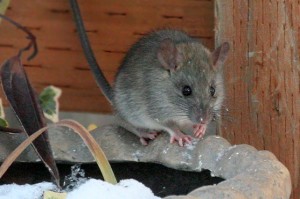
Fall is just around the corner — in fact, we’re holding our annual fall meeting tomorrow morning — which, in our neighborhood, means that hundreds of thousands of acres of crops are being harvested and hundreds of thousands of rodents are fleeing the fields. We usually talk about mice more as fall turns to winter, but today we’re going to look at a few ideas for mouse-proofing your home. This is a great time to do it.
Mouse control is usually accomplished with rodenticide baits, glue boards (sticky traps), or snap traps, all of which can result in a dead mouse in your home. Better dead than alive, but most homeowners would prefer no mouse at all. This is where exclusion comes in, a series of steps taken to prevent mice from entering a structure.
The typical house mouse is 3-4 inches long and weighs less than one ounce. It can probably fit through a hole the size of a nickel; a smaller mouse might be able to squeeze through a hole the size of a dime. To prevent mice from entering your home, seal all holes with steel wool, silicon caulking, and/or plumber’s foam.
An attached garage is by far the easier part of a home for mice to access. Even when the door isn’t wide open, there may be gaps at the corners large enough to admit mice, crickets, spiders, and other pests. Once inside the garage, mice may be able to find their way into the house or crawlspace through unsealed holes for utility lines, or they might set up shop in the garage, feasting on bird seed, pet food, and other stored edibles. Placing a bait station or trap on each side of the garage door often takes care of a homeowner’s mouse problem, even if no additional steps are taken.
It’s not unusual to find holes in old foundations, and even brand new houses aren’t necessarily mouse-proof. Walk around the outside of your home, locate any unsealed holes in the foundation, and seal them. Don’t forget to check the vents; these might not be screened properly, and can sometimes become loose and fall out onto the ground, creating an opening large enough for just about anything to enter the crawlspace. It’s usually helpful to place rodenticide in the crawlspace or basement, provided that it’s out of the reach of pets. In a basement, rodenticide should be placed in child-proof bait stations.
Once the exterior of your home has been pest-proofed properly, check all pipes and lines entering the house. Often there are large gaps around water pipes under kitchen and bathroom sinks, which should be blocked with steel wool or otherwise sealed. It might not be necessary to place bait stations or traps in these areas; it’s probably better to watch for signs of mouse activity indoors before using rodenticide or traps inside your home.
Published: August 29, 2013
Our pest control services cover a wide area on the Eastern Shore of Delaware and Maryland.
Maryland – Coastal and Inland areas of Ocean City, Ocean Pines, Berlin, Snow Hill, Salisbury, and nearby areas
Delaware – Coastal and Inland areas of Fenwick Island, Bethany Beach, Dewey Beach, Rehoboth Beach, Lewes, Selbyville, Seaford, Georgetown, Milton, and nearby Sussex County areas
Not sure if we service your area? Give us a call, 800-908-1000!
Your satisfaction is our priority, and our track record speaks for itself. Join our long list of happy customers and let us handle your pest control needs with utmost proficiency.